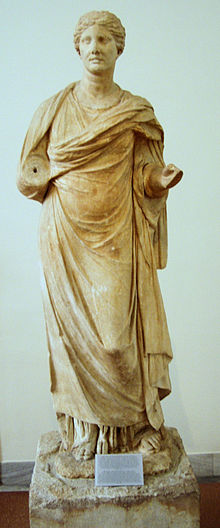Statue of the priestess Aristonoe
The statue of the priestess Aristonoe in the National Archaeological Museum of Athens (NAMA) with the inventory number 232 is dated to the third century BC. Dated.
The statue is largely preserved, apart from a few nicks. Only the right forearm and the left hand are missing. Both forearms were made and attached separately. The head was also worked as an insert head, but is completely preserved. The plinth and the rectangular base have also been preserved. Aristonoe stands facing the viewer. The right one is the standing leg , the left one the slightly bent free leg . The arms are bent and stretched forward. The head is turned slightly to the right. The braided hair is carefully arranged backwards and parted over the forehead. The body is completely covered except for the front feet, forearms, neck and head. Aristonoe wears a chiton and a himation .
The statue made of Pentelic marble was found in 1890 in the temple of Nemesis in Rhamnous , long believed to be the temple of Themis . The statue, about 1.62 meters high, with a 38 centimeter high, 61 centimeter wide and 62 centimeter deep base is dedicated to the goddess Nemesis according to a base inscription . It was founded by Hierocles, the son of Hieropoios and Aristonoe. According to the inscription, Aristonoe is the daughter of a Nicocrates of Rhamnous.
Inscription:
- Θέμιδι καὶ Νεμέσει
- Ἱεροκλῆς Ἱεροποιοῦ Ραμνούοιος
- ὰνέθηκε τὴν μητέρα Ἀριοτονόην
- Νικοκράτου Ραμνουοίου ἱέρειαν
- Νεμέσεως
literature
- Nikolaos Kaltsas : Sculpture in the National Archaeological Museum, Athens , The J. Paul Getty Museum, Los Angeles 2002 ISBN 0-89236-686-9 , p. 274.
Web links
- Statue of a priestess in the Arachne archaeological database
